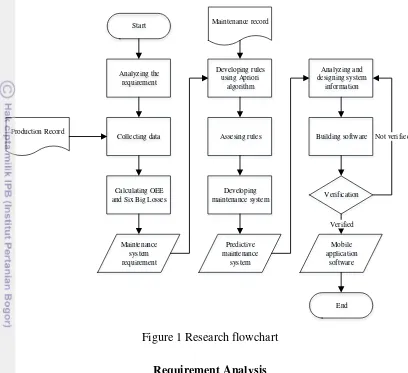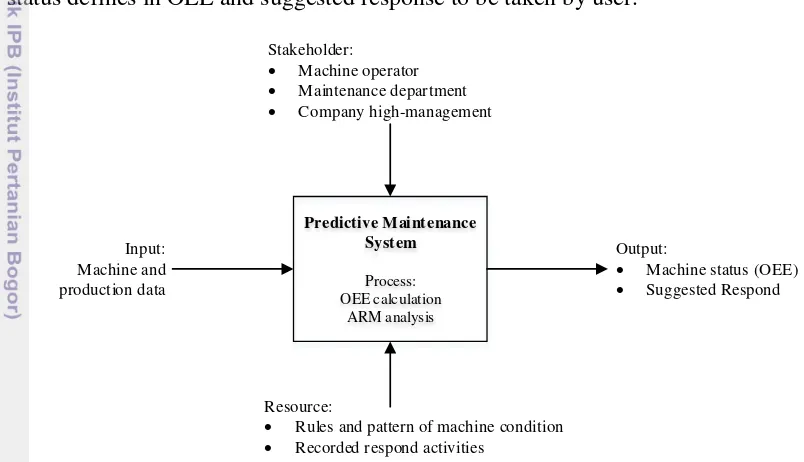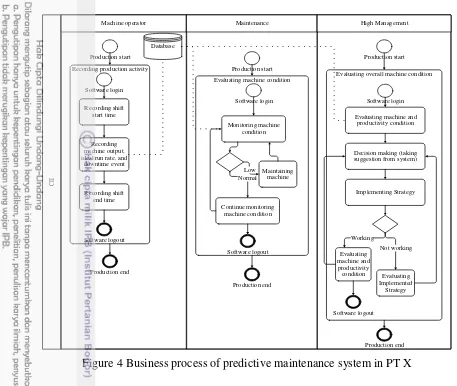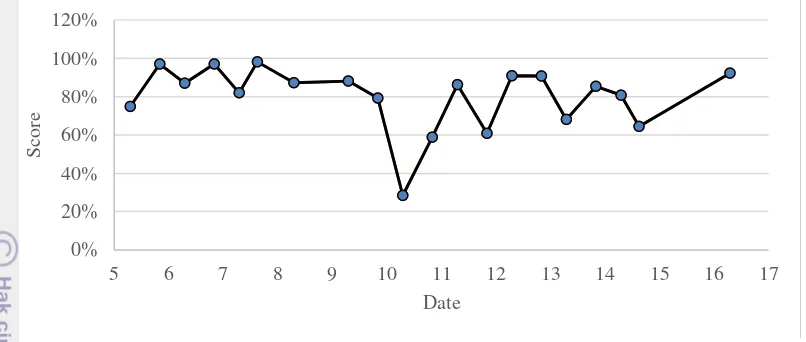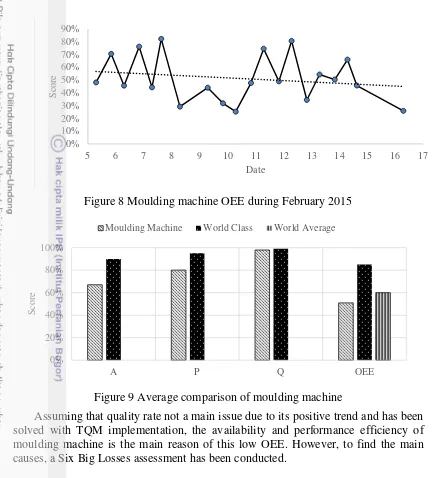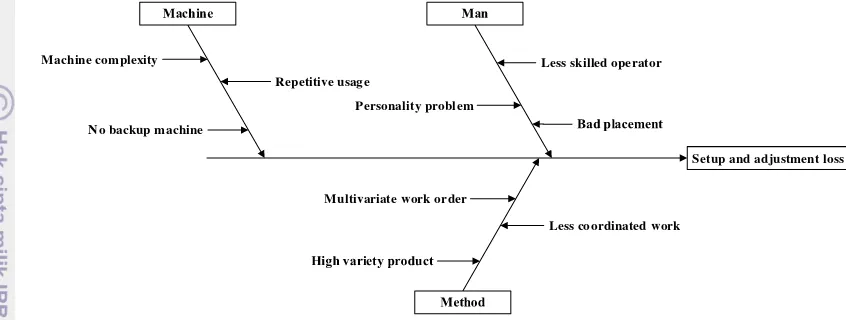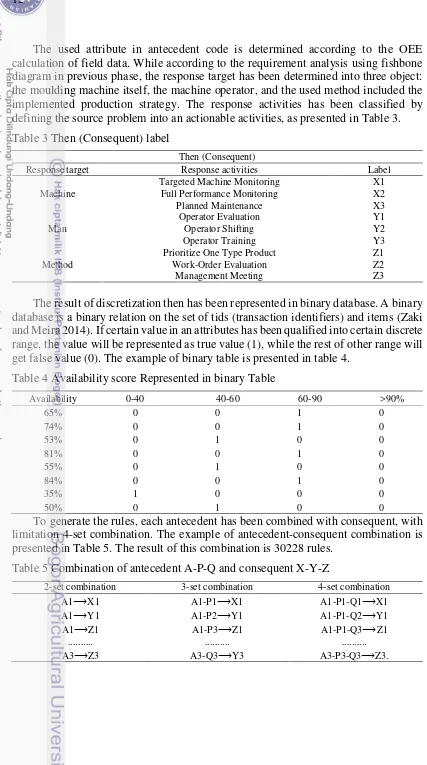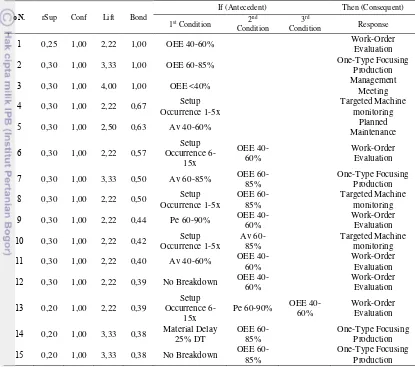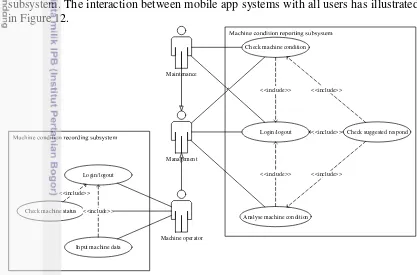AN ANALYSIS AND DESIGN OF PREDICTIVE MAINTENANCE
SYSTEM USING ASSOCIATION RULE MINING
IN MOULDING MACHINE PT X
IMAM MUHARRAM ALITU
DEPARTMENT OF AGROINDUSTRIAL TECHNOLOGY
FACULTY OF AGRICULTURAL TECHNOLOGY AND ENGINEERING BOGOR AGRICULTURAL UNIVERSITY
DECLARATION OF ORIGINALITY
AND COPYRIGHT TRANSFER
I hereby declare that An Analysis and Design of Predictive Maintenance System Using Association Rule Mining in Moulding Machine PT X is my own work and to the best of my knowledge it contains no material previously published in any university. All of incorporated originated from other published as well as unpublished papers are stated clearly in the text as well as in the references.
Hereby, I state that the copyright to this paper is transferred to Bogor Agricultural University.
Bogor, June 2015
ABSTRACT
IMAM MUHARAM ALITU. An Analysis and Design of Predictive Maintenance System Using Association Rule Mining in Moulding Machine PT X. Supervised by: TAUFIK DJATNA
One of the challenges in the implementation of Total Productive Maintenance (TPM) in the manufacturing industry is a slow managerial decision-making to respond the condition in the factory. This research investigates the answers of these challenges by analyzing and modeling the equipment condition and the response of actions required in a wooden door manufacturing industry. TPM implementation in this company has deployed the Overall Equipment Effectiveness (OEE) measurement as an indicator of the equipment utilization and condition. Through an analysis and modeling of the OEE value obtained from the factory, the formulation of Association Rule Mining (ARM) aims to find a rule that shows the well computed relationship between measurable indicators of OEE with the response of action required to take in certain condition of machine utilization. Results obtained from ARM accelerate the decision to establish an appropriate TPM management strategy based on the rules. The generated dynamic rules form and facilitate the process of decision-making by related stakeholders. Furthermore, relying on these rules the action taken by the company induced to a higher reliable and increasing the effectiveness of response and efficiency of time and costs.
Keywords: Overall Equipment Effectiveness, Association Rule Mining, Data Mining,
Total Productive Maintenance
ABSTRAK
IMAM MUHARAM ALITU. Analisis dan Perancangan Sistem Predictive Maintenance
Menggunakan Association Rule Mining pada Mesin Moulding PT X. Dibimbing oleh: TAUFIK DJATNA
Salah satu tantangan dalam pelaksanaan Total Productive Maintenance (TPM)
dalam industri manufaktur adalah pengambilan keputusan manajerial yang lambat untuk menanggapi kondisi di pabrik. Penelitian ini menjawab tantangan tersebut dengan menganalisis dan memodelkan kondisi peralatan dan respon tindakan yang diperlukan dalam industri manufaktur pintu kayu. Implementasi TPM di perusahaan ini telah
menggunakan Overall Equipment Effectiveness (OEE) sebagai indikator pengukuran
pengukuran penggunaan dan kondisi peralatan. Melalui analisis dan pemodelan dari nilai
OEE yang diperoleh dari pabrik, perumusan Association Rule Mining (ARM) bertujuan
untuk menemukan aturan yang menunjukkan hubungan di antara indikator terukur dari OEE dengan tindakan yang diperlukan untuk diambil dalam kondisi tertentu pada penggunaan mesin. Hasil yang diperoleh dari ARM mempercepat pengambilan keputusan untuk menetapkan strategi manajemen TPM yang tepat berdasarkan aturan yang telah dibuat. Aturan dinamis yang dihasilkan membentuk dan memfasilitasi proses pengambilan keputusan oleh para pengambil kebijakan terkait. Selanjutnya, mengandalkan aturan ini tindakan yang dilakukan oleh perusahaan diharapkan untuk lebih dapat diandalkan dan meningkatkan efektivitas tindakan yang diambil dan efisiensi waktu dan biaya.
Keywords: Overall Equipment Effectiveness, Association Rule Mining, Data Mining,
AN ANALYSIS AND DESIGN OF PREDICTIVE MAINTENANCE
SYSTEM USING ASSOCIATION RULE MINING
IN MOULDING MACHINE PT X
IMAM MUHARRAM ALITU
Undergraduate Thesis
as partial fulfillment of the requirements for the degree of Bachelor in Agricultural Technology
in the Agroindustrial Technology Study Program
DEPARTMENT OF AGROINDUSTRIAL TECHNOLOGY
FACULTY OF AGRICULTURAL TECHNOLOGY AND ENGINEERING BOGOR AGRICULTURAL UNIVERSITY
Thesis Title : An Analysis and Design of Predictive Maintenance System using Association Rule Mining in Moulding Machine PT X
Name : Imam Muharram Alitu
Registration Number : F34110062
Approved by
Dr Eng Taufik Djatna STP MSi Supervisor
Acknowledge by
Prof Dr Ir Nastiti Siswi Indrasti
Head of Department of Agroindustrial Technology
PREFACE
Praise to Allah Subhanahu Wa Ta’ala for His blessings and generosity given to me, so I can stand a chance for completing my work as a requirement to achieve an academic title of Bachelor of Agricultural Technology from Department of Agroindustrial Technology, Bogor Agricultural University. Peace be upon Prophet Muhammad shallallahu 'alaihi wa sallam and all of his best friends for giving the inspiration and being the most suitable figures to be followed.
About one years ago, I took a capstone course as my research. At that time, I believe that everything will be normal. But, it turned out to be a long battle against my procrastination habit and the self-limitation. It pushed myself into a different level and taught me a new knowledge, and a new perspective to solve the issues around myself. For all of that, I would like to express my sincere appreciation to Dr Eng Taufik Djatna STP MSi, not only for his support and patience in supervising me to conduct the research, but also for his guidance for my personality improvement.
My deepest love and appreciation is for my parents, Wisno A. Alitu and Rahmin Utia, for their love, support, and pray for me, to pursue my dream overseas to get a higher and better education. I would like to thank my beloved siblings Ikram Syawal, Aqila Fitri, and Atikah Nursyawal for their encouragement and inspiration to complete my study. Wish you all always under protection of Allah Subhanahu Wa Ta’ala.
Best regard is sent to Mr Amin Soetara, Mr M.Sophie, Mr Alhadi, and the other stakeholder of PT X, for their guidance, support, and shared experience during the internship program till this research finished. Thank you all very much.
Truth be told, this undergraduate thesis is a brief report of this long one year process. However, this undergraduate thesis cannot shows the long way spent in lab with my research fellow, Denny Rahmady, Raja Ihsan, Yudhistira Chandra, Delmar Zakaria, and Septian Ventura. It cannot visualize the hard time of internship program with Alfiyan Hudan and Hanif Pramudya. It cannot shows the three years joy of life in Kopadjo with Bagas Sakti, Aji Wibowo, Tio Nandika, Rian Wijaya, Irkham Triaji, and Andika Rachman. It cannot beat my Dota party Irham Raenaldi, and Ade Supriatna. It cannot replace the code jam of MAPRES 2014 Purwa Ari, Ajeng Rosecha, Hardianti Achas, Nabila An Nadjib, Salman Al Farisi, Putri Wulandari and our supervisor Isma Apupianti. It cannot erase the memories with AF2013 organizing committee Ari Adinugraha, Fadila, Reza Rochili, Zefika Zahlinar, Camelia Hilma, Ian Nurdiansyah, and the others crew. Thank you all for supporting me to pursue this degree along with all members of Tinformers, P2, Matatta, Himalogin, Matipala, and Labkom fellow.
Respectfully, I would like to thank Gugi Yogaswara, Hanum Rachmawati, Adya Dinda, Ria Octavia, Dedi Syukur, and Fitrian Rakadiaputra for being my best friends, mentor, inspiration, and partner in this tough time. Thanks for the guidance and support. I wish we can always be our self, and always learn to be a better person.
Finally, thanks to you to be a reader of my thesis. I wish this work will give a benefit for all of us. Correction and recommendation are gladly accommodated for the
sake of science and knowledge. Because Steve Jobs says: “Stay hungry. Stay Foolish.”
Carpe diem. Cogito ergo sum.
Bogor, June 2015
TABLE OF CONTENTS
TABLE OF CONTENT
LIST OF FIGURES
LIST OF TABLES
LIST OF APPENDIX
INTRODUCTION 1
Background 1
Problem Definition 2
Research Objectives 2
Research Boundaries 2
Research Benefits 2
METHODOLOGY 2
Requirement Analysis 3
System Entity Analysis 3
Business Process Analysis 4
Machine Condition Analysis 4
Predictive Maintenance System Development 5
Apriori Algorithm 5
Rule Assessment 5
System Information Design 6
Unified Modeling Language 6
Mobile Application Development 6
System Verification 6
RESULT AND DISCUSSION 7
Requirement Analysis 7
System Entitiy Analysis 7
Business Process Analysis 7
Machine Condition Analysis 8
Predictive Maintenance System Development 11
Apriori Algorithm 11
Rule Assessment 13
System Analysis and Design 14
Unified Modeling Language 14
Mobile Application Development 15
System Verification 16
Advantage and Disadvantage 17
CONCLUSION AND RECOMMENDATION 17
Conclusion 17
Recommendation 18
REFERENCE 18
LIST OF FIGURES
1 Research flowchart 3
2 Basic framework of system entity 3
3 System entity of PT X predictive maintenance system 7 4 Business process of predictive maintenance system in PT X 8 5 Moulding machine availability during February 2015 8
6 Moulding machine performance during February 2015 9
7 Moulding machine quality during February 2015 9
8 Moulding machine OEE during February 2015 10
9 Average comparison of moulding machine 10
10 Pareto chart of Six Big Losses 10
11 Causal-effect (fishbone) diagram showing setup and adjustment factors 11 12 Use case diagram of predictive maintenance system mobile app 14 13 Sequence diagram of predictive maintenance system mobile app 15 14 Class diagram of predictive maintenance system mobile app 15
15 Interface of FOOEC 16
16 Suggested response of FOOEC 16
LIST OF TABLES
1 Six Big Losses classification 5
2 If (Antecedent) label 11
3 Then (Consequent) label 12
4 Availability score Represented in binary Table 12
5 Combination of antecedent A-P-Q and consequent X-Y-Z 12
6 Top 15 rules ranked by bond 13
7 System verification 17
LIST OF APPENDIX
1 Table of OEE calculation result 20
2 Table of qualified rules resulted by ARM 21
1
INTRODUCTION
Background
As one of the global company in wooden door manufacturing industry which is located in Gunung Putri, West Java, PT X sells high-variation products that are fully exported across the world to fulfill market demand. It has been identified during internship program from June to August 2014 that with limited number of machine and limited production capacity, this high variation production leads to high a changeover rate in the main factory. To adjust the production machine from one type of product to another one, the machine must be turned off which resulted to a higher downtime. Early 2015 data from maintenance department in PT X shows that 33% of planning production time is the downtime. High percentage of downtime in this company results to a slower production rate and higher overtime.
In fact since 2013, PT X management has been implemented a Total Productive Maintenance (TPM) program to maintain the factory plant and its equipment. Defines by Nakajima (1988), as described in Wajkira and Singh (2013), TPM is manufacturing program designed primarily to maximize the effectiveness of equipment by participation and motivation of the entire workforce. TPM strategy implemented in this company is a benchmarked strategy from another manufacturing company. But, due to lack of human resources, the implemented strategy could not significantly affect the machine performance.
As a part of capstone program which leads to real industry problem solving, this research is a follow up to internship program during June to August 2014 in PT X. Using three courses from Department of Agroindustrial Technology to support the program namely Production Planning and Controlling, Operation Research, and System Analysis and Decision Making, this research aims to solve the PT X maintenance problem using structured research approach. It has been by literature review that data mining is one of the appropriate approach to solve the maintenance problem in PT X.
According to a brief explanation in Bastos et. al (2012), data mining techniques supports the development of predictive maintenance system to improve plant and machine condition in industry. Due to the ability to show the dependencies between attributes and define it in association rule as described in Arrahman (2011), Azima (2013), and Thamrin (2015), this research use Association Rule Mining (ARM) as a distinct method to another works, like Putri (2013) did using AHP, to solve manufacturing industry maintenance problem.
Nowadays, information and communication technology (ICT) has made much impact on everyday life. The manufacturing industry for example has experienced a major change from manual to automated manufacturing processes (Rosman et. al 2014). According to this fact, there is a requirement to develop the predictive maintenance system on a certain platform that can improve the system functionality and usability. Furthermore, data mining technique that is used in this research works by applying algorithms for extracting patterns from the data stored in a data warehouse. A mobile application has been developed in this research to fulfill that requirement.
2
describes the result of this research, and the explanation about the outcomes. Finally, the conclusion and recommendation for this research provided in Chapter 4.
Problem Definition
PT X has a problem with their productivity due to their ineffective maintenance system. Currently, implemented TPM strategy is required to be improved using structured research approach. By using data mining techniques to make predictive maintenance system, there is a requirement to build an information system as platform/infrastructure for the system works.
Research Objectives
This research aims to solve the problem in previous section with the following objectives:
(1) To analyze the requirement of the maintenance system in PT X
(2) To develop a predictive maintenance system based on the requirement analysis (3) To integrate the predictive maintenance system into information system and to evaluate the functionality of the system
Research Boundaries
This research is bounded only to analyze and develop a predictive maintenance system for a PT X’s moulding machine in the third line production of factory A and to build information system using the developed predictive maintenance system.
Research Benefits
The maintenance system developed in this research is a predictive maintenance system built in information system that can be used to improve maintenance system in manufacturing company, especially PT X, because this system was developed using their data. This research also provides a breakthrough solution about how data mining techniques can be used to solve operation management problem in manufacturing industry. For the author itself, this research is undergraduate thesis as a final assignment to pursue his degree in Agroindustrial Technology Department. The knowledge and experience obtained from this research, during internship program to thesis writing, has improved the author’s skill itself.
METHODOLOGY
3
to accomplish the third objective. All of this research process has been conducted since January to May 2015 in PT X and Bogor Agricultural University.
Start
Figure 1 Research flowchart
Requirement Analysis
Requirement analysis is a method that is concerned with determining the goals, functions, and/or constraint of certain problem (Laplante 2007). In this research requirement analysis was conducted to determine the system requirement with analyze the business process of maintenance system and current condition of the machine.
System Entity Analysis
Wasson (2006) defines that system entity is one method that can represent input, process and output of system. By knowing system entity of a system, the requirement of the system can be known. The basic framework of system entity is illustrated in Figure 2. The identification of system analysis has been conducted by field observation and interview in PT X.
4
Business Process Analysis
To analyze the business process mechanism, Business Process Model and Notation (BPMN) has been made using a couple of templates in Microsoft Visio. White and Miers (2008) defines that development of BPMN aimed to identify the business process stages in detail and completely in the digital system, or in this case, predictive maintenance system. The output of this analysis are roles of each stakeholders, rules in business process, and data flow in the system.
Machine Condition Analysis
The moulding machine has been chosen as research target due to its importance as component profiler that make this machine has high changeover rate. The data used in this analysis is secondary data collected from PT X production department record. First, the data was processed with OEE measurement. OEE is a key performance index to measure the effectiveness of the used equipment, plant, or machine (McCharty and Rich 2004). The formula of OEE defined by Nakajima (1998) in McCharty and Rich (2004) is shown below.
= � × × (1)
Wherein:
A : availability (%)
Pe : performance efficiency (%) Qr : quality rate (%)
Availability means the actual available time to produce goods using a machine. Performance rate shows the products produced according to the available time. Then the quality rate concludes the good products produced along the available time into OEE score (Kumar and Suresh 2008). Each of the factors that compose the OEE formula can be calculated by processing production data and machine condition.
� = � ÷ � (2)
Wherein:
OT : operating time (minutes)
POT : planned operating time (minutes)
= ÷ � (3)
Wherein:
RRR : real run rate (pieces/minutes) IRR : ideal run rate (pieces per minutes)
= � ÷ � (4)
Wherein:
GP : good product (pieces) TP : total product (pieces)
5
Table 1 Six Big Losses classification
Type Availability Performance Quality
Planned Setup and
adjustment Reduced speed Startup losses
Unplanned Breakdowns Idling and minor stoppages
Defects and rework
Predictive Maintenance System Development
Basically, three types of maintenance are corrective, preventive, and predictive maintenance. The strategy developed in this research is predictive maintenance. This research focused on predictive maintenance system than other maintenance system, like autonomous maintenance and preventive maintenance, due to the capability of data mining (Bastos et. al 2012). Using measurable parameters when breakdown is eminent, predictive maintenance intends to make an intervention to the machine itself or related factors before harmful events may occur (Ahmed et. al 2010). Data mining could clarify the relationship between the parameters and the response variable observed with intervention response that will be taken by the related stakeholder.
One of data mining techniques is ARM. Arrahman (2011) shows the implementation of ARM to determine customer relationship management strategy. Azima (2013) shows the implementation of ARM in cross-selling in a mobile application. Thamrin (2015) uses ARM to determine the relation between variable in smart packaging color indicator. All of these previous works shows the application of ARM due to its ability to show the dependencies between attributes and define it in association rule. According to facts above, ARM became the focus of this research.
Apriori Algorithm
ARM start with mining frequent items with their support values using frequent item mining algorithm like Apriori algorithm. This algorithm works over numeric or non-numeric data because the data itself will be converted into code (Zaki and Meira 2014). All of the attributes were pre-processed with discretization in a certain range. Measurable parameter like OEE measurement result was converted into antecedent code, while response activities converted into consequent code. The data of each attributes was compiled and converted into discrete binary data. Then, after combining the item-sets to combination 2-item sets up to 4-item sets, Apriori algorithm formed the candidate item set, then it generated large item set consist of rules (Agrawal and Srikant 1994). Each combination of generally called as transaction.
Rule Assessment
Although there are many rules obtained, most of the rules were discarded or eliminated due to their low value with rule assessment. Rule assessment is a method consist of different rule interestingness measures to quantify the dependence between the antecedent and consequent (Webb and Wrycza 2006). There are 4 measures used in this assessment: support, confidence, lift, and bond.
6
Relative support (rsup) or support value compared relatively to the size of database was defined in (6), with |D| is a total of transaction in database.
⟶ = X ∩ = | | (5)
⟶ = ∩ /| | (6)
Confidence (conf) of a rule is the conditional probability that a transaction contains the consequent Y given that it contains the antecedent X.
⟶ = ∩ / (7)
Lift of a rule is a ratio of the observed joint probability of X and Y to the expected joint probability if they were statistically independent.
� ⟶ = ⟶ / (8) Bond shows the strength of item set with comparing conjunctive (combination contain only true value) and disjunctive (total of all combination) of each transaction.
⟶ = ∩ / ∩ (9)
All of these measures must be determined with user threshold to get qualified rules. User threshold determined with trial and error method. If the user threshold too high, the rules resulted by rule assessment is too few, and if it too low, there will be too many rules and the assessment will be uncomprehensive. The qualified rules obtained from ARM has been developed into predictive maintenance system.
System Information Design
System design is the process of planning a new business system or one to replace or complement an existing system. While the analysis specifies what the system should do, design states how to accomplish the objective (Bajaj and Wrycza 2009).
Unified Modeling Language
System design stages are conducted using Unified Modelling Language (UML) to present the visualization of information system of predictive maintenance system developed by ARM. Unified Modelling Language (UML) is a group of diagram used for visualizing a model design of a system or software (Walzawick 2013). Based on BMPN that developed in previous phase, use case, sequence, and class diagram has been made using a couple of templates of Microsoft Visio.
Mobile Application Development
As a result of components design and its interoperability. The application is developed on Intel XDK IDE (Integrated Development Environment) using JavaScript programming language, while the interface design is handled using HTML5 (HyperText Markup Language 5) and CSS3 (cascading Style Sheets 3). To store the data, a SQL database has been used. The database itself uploaded into web-hosting server to store the data on internet so it can ease the implementation on the field and increase user experience.
System Verification
7
functionality of ARM model in the predictive maintenance system has been verified. The verification stages conducted by comparing the implemented system with the system requirement determined in requirement analysis.
RESULT AND DISCUSSION
Requirement Analysis System Entity Analysis
The system entity of PT X predictive maintenance system shows that three stakeholder that will be the user of information system: machine operator, maintenance department, and PT X high-management. Using rules and pattern of machine condition, this system process inputted machine and production data into machine status defines in OEE and suggested response to be taken by user.
Predictive Maintenance System
Process: OEE calculation
ARM analysis Input:
Machine and production data
Output:
Machine status (OEE) Suggested Respond Stakeholder:
Machine operator Maintenance department Company high-management
Resource:
Rules and pattern of machine condition Recorded respond activities
Figure 3 System entity of PT X predictive maintenance system
Business Process Analysis
8
C
II
Machine operator Maintenance High Management
Recording production activity ideal run rate, and
downtime event
Figure 4 Business process of predictive maintenance system in PT X
Machine Condition Analysis
According to production department data of PT X for February 2015, moulding machine has average availability score 67% which is below the world class availability score 90% (Wajkira and Singh 2013). Linear trend line gradient shows negative value -0.0015, which means a declining machine’s availability. An unexpected breakdown may occurs if this condition still continue that will disrupt production and lead to losses.
Figure 5 Moulding machine availability during February 2015
9
Figure 6 Moulding machine performance during February 2015
The average performance score of moulding machine is 80%, which also below world class performance efficiency. Linear trend line gradient is -0.0103 which means a declining condition of machine performance. Inefficiency in machine performance can also means a resource wasting, slow working labor, and/or low productivity.
Figure 7 Moulding machine quality during February 2015
Contradicted with two previous factors, average quality score of moulding machine is 98% which is nearly approach the world class quality rate 99%. The linear trend line gradient 0.0004 shows a positive inclining of machine output quality. The positive trend also shows the successfulness of quality department in PT X that has been focused to guarantee their product quality for recent 3 years using a Total Quality Management (TQM) program.
Using three factors above, availability, performance efficiency, and quality rate, OEE of moulding machine has been calculated. Average OEE score of moulding machine is 51% which is far from world class OEE 85%, even with world average 60%. A dangerous declining OEE of the machine also shows in linear trend line gradient -0.0106. It indicates improvements are required urgently. The comparison of average score of availability, performance efficiency, quality rate, and OEE are summarized in Figure 9.
0% 20% 40% 60% 80% 100% 120%
5 6 7 8 9 10 11 12 13 14 15 16 17
Sco
re
Date
93% 94% 95% 96% 97% 98% 99% 100% 101%
5 6 7 8 9 10 11 12 13 14 15 16 17
Sco
re
10
Figure 8 Moulding machine OEE during February 2015
Figure 9 Average comparison of moulding machine
Assuming that quality rate not a main issue due to its positive trend and has been solved with TQM implementation, the availability and performance efficiency of moulding machine is the main reason of this low OEE. However, to find the main causes, a Six Big Losses assessment has been conducted.
Figure 10 Pareto chart of Six Big Losses
0%
Moulding Machine World Class World Average
11
As presented in Figure 10, according to the PT X maintenance department data, 73% of productivity loss in moulding machine is setup and adjustment loss. The setup and adjustment loss occur when the production must be stopped to prepare the machine for subsequent production (Ahmed et. al 2010). The causes of setup and adjustment losses has been identified and visualized using causal-effect (fishbone) diagram.
Setup and adjustment loss
Figure 11 Causal-effect (fishbone) diagram showing setup and adjustment factors
OEE calculation, Six-Big Losses assessment, and source problem identification using fishbone diagram was aimed to identifying used machine condition, and provide a better visualization of current moulding machine condition.
Predictive Maintenance System Development Apriori Algorithm
To ease the combination process using Apriori algorithm, every attributes has been grouped into certain range and labeled through discretization. Discretization, also called binning, converts numeric attributes into categorical ones. Discretization can also help in reducing the number of values for an attribute, especially if there is noise in the numeric measurements (Zaki and Meira 2014). The measurable parameter of moulding machine has been determined as rule antecedent, while response activities of PT X management has been determined as rule consequent.
Table 2 If (Antecedent) label
If (Antecedent)
Parameter Range Label Parameter Range Label Parameter Range Label
12
The used attribute in antecedent code is determined according to the OEE calculation of field data. While according to the requirement analysis using fishbone diagram in previous phase, the response target has been determined into three object: the moulding machine itself, the machine operator, and the used method included the implemented production strategy. The response activities has been classified by defining the source problem into an actionable activities, as presented in Table 3.
Table 3 Then (Consequent) label
Then (Consequent)
Response target Response activities Label
Machine
Targeted Machine Monitoring X1
Full Performance Monitoring X2
Planned Maintenance X3
Man
Operator Evaluation Y1
Operator Shifting Y2
Operator Training Y3
Method
Prioritize One Type Product Z1
Work-Order Evaluation Z2
Management Meeting Z3
The result of discretization then has been represented in binary database. A binary database is a binary relation on the set of tids (transaction identifiers) and items (Zaki and Meira 2014). If certain value in an attributes has been qualified into certain discrete range, the value will be represented as true value (1), while the rest of other range will get false value (0). The example of binary table is presented in table 4.
Table 4 Availability score Represented in binary Table
Availability 0-40 40-60 60-90 >90%
To generate the rules, each antecedent has been combined with consequent, with limitation 4-set combination. The example of antecedent-consequent combination is presented in Table 5. The result of this combination is 30228 rules.
Table 5 Combination of antecedent A-P-Q and consequent X-Y-Z
2-set combination 3-set combination 4-set combination
A1⟶X1 A1-P1⟶X1 A1-P1-Q1⟶X1
A1⟶Y1 A1-P2⟶Y1 A1-P1-Q2⟶Y1
A1⟶Z1 A1-P3⟶Z1 A1-P1-Q3⟶Z1
... ... ...
13
Rule Assessment
To get qualified rules, a rule assessment has been conducted. Using trial and error method, the user threshold has been determined. The minimum relative support, confidence, lift, and bond used in this research is 0.2, 1, 2, and 0.2. By using this threshold, the rule assessment was resulting 83 qualified rules. Table 6 below shows the summary of top 15 qualified rules ranked by bond.
Table 6 Top 15 rules ranked by bond
.
No rSup Conf Lift Bond
If (Antecedent) Then (Consequent) 1 0,25 1,00 2,22 1,00 OEE 40-60% Work-Order
Evaluation
2 0,30 1,00 3,33 1,00 OEE 60-85% One-Type Focusing Production
3 0,30 1,00 4,00 1,00 OEE <40% Management Meeting
12 0,30 1,00 2,22 0,39 No Breakdown OEE 40-60%
14 0,20 1,00 3,33 0,38 Material Delay 25% DT
OEE 60-85%
One-Type Focusing Production
15 0,20 1,00 3,33 0,38 No Breakdown OEE 60-85%
One-Type Focusing Production
Using 83 qualified rules resulted by ARM, a model of maintenance strategy was developed. In this model, the antecedent of the rules consists of measurable parameters that describe the machine condition, up to three condition, while the consequent of the rules consists of response to be taken if the condition in antecedent was occurred. For example, if condition of the machine, in this case moulding machine, was showed OEE value 40-60%, then the management should conduct a work-order evaluation. OEE with value below 60% is lower than world average OEE. Manufacturing company with high changeover rate like PT X maybe has low OEE due to the current work-order. So, to prevent further decreasing in OEE value, the work-order should be evaluated.
14
can increase the probability of successfulness of predictive maintenance. Using ARM, the dependencies between variables has shown clearly, and the decision to be taken to respond machine-related problems on the factory, can be easily considered not only based on observable parameters like machine sound and vibration, but also to unobservable parameters like OEE.
System Analysis and Design Unified Modeling Language
The use case below shows the usability of predictive maintenance system mobile application (app). The machine operator use the mobile app in recording subsystem meanwhile the high-management and maintenance act use FOEEC in reporting subsystem. The interaction between mobile app systems with all users has illustrated in Figure 12.
Machine operator Login/logout
Management Maintenance
Input machine data Check machine status
<<include>>
Login/logout Check machine condition
Analyse machine condition <<include>>
<<include>>
Check suggested respond
<<include>> <<include>>
<<include>>
<<include>>
Figure 12 Use case diagram of predictive maintenance system mobile app
15
Figure 13 Sequence diagram of predictive maintenance system mobile app
To illustrate the relation between object in database in predictive maintenance system mobile app, a class diagram has been made and presented in Figure 13.
user
Figure 14 Class diagram of predictive maintenance system mobile app
Mobile Application Development
16
Figure 15 Interface of FOOEC
Figure 15 shows four functional pages of FOOEC application, input data pages with three machine status pages with chart, while figure 16 shows the main function of FOEEC that show the machine condition in OEE chart with suggested response to be taken by the management.
Figure 16 Suggested response of FOOEC
System Verification
17
Table 7 System verification
No BPMN Model Implementation in mobile application Status 1 Account
authorization (login/logout)
Implemented by providing an login page and logout button
Done
2 Machine condition measurement
Implemented by automatically calculate the OEE using the inputted data
Done
3 Machine status visualization
Implemented by visualize the OEE and the constituent factors using Google Chart API
Done
4 Support the decision-making process
Implemented by using if-else algorithm developed by the rules generated by the ARM to suggest a response to be taken by the user
Done
Overall, the functionality of FOEEC mobile application has been fulfill the requirement of predictive maintenance system. Furthermore, FOEEC will be implemented in PT X to be tested by the real user with real problem in real condition.
Advantage and Disadvantage
The implementation of ARM to develop TPM strategy is very potential. To implement ARM model to develop TPM strategy for other machine in PT X or even in another manufacturing company, the management can change used attributes and data in ARM so it will generated rules that fit and suit with the machine condition itself. The advantage of this model is generated dynamic rules that always updated by the data changing comparing to other strategy development tool like Analytic Hierarchy Process that uses static data (Bastos et. al 2012).
As one of data mining technique, the implementation of ARM to the TPM is a right choice, due to its ability to handle big-data with high velocity and volume that is generated by machine condition. But, the velocity of the data used in this research is low due to the manual data acquisition. This research also shows the necessity of ICT implementation to optimize the usability of data mining techniques to solve manufacturing industry problem like machine maintenance. Without ICT implementation as shown this research, the functionality of data mining techniques like ARM is hardly to be verified and directly implemented to the field.
CONCLUSION AND RECOMMENDATION
Conclusion
18
other machine parameters was processed with ARM using Apriori algorithm and generates 30228 if-then rules. Rule assessment has conducted to qualify rules using user threshold to limit support, confidence, lift, and bond value. According to 83 qualified rules, a predictive maintenance strategy has been built by developing the qualified rules. As addition, the model itself has been mounted to information system. Using if-then rules generated by ARM, an if-else looping algorithm has been developed to mount the model to the mobile application. The system information has been developed in a form of mobile application to make it more user-friendly, flexible, and increase the usability.
Recommendation
The OEE measurement itself can be improved using sensor to ease data acquisition and increase data velocity. To ease the implementation of data mining techniques like ARM in the field, it is advisable to implement ICT such as mobile application. Furthermore, using the same approach this ARM and other data mining techniques model can also be modified to be implemented in corrective and preventive maintenance.
REFERENCE
Agrawal R, Srikant R. 1994. Fast algorithms for mining association rules. In: Bocca JB, Jarke M, Zaniolo C, editor. Proceedings of the 20th International Conference on Very Large Data Bases. Very Large Data Bases Conference; 1994 September 12-15; Santiago de Chile, Chile. San Fransisco (US): Morgan Kaufmann. pp. 487-499.
Ahmed T, Ali SM, Allama MM, Parvez MS. 2010. A total productive maintenance (TPM) approach to improve production efficiency and development of loss structure in a pharmaceutical industry. Global Journal of Management and Business Research. 10(2), pp. 186-190.
Arrahman T. 2011. Customer Relationship Management for Determining of Sales Strategy using Association Rules Mining Technique [Undergraduate Thesis]. Bogor (ID): Bogor Agriculture University.
Azima MR. 2013. Mobile Application for Cross Selling on Customer Relationship Management in Tire Agroindustry. [Undergraduate Thesis]. Bogor (ID): Bogor Agriculture University.
Bajaj A, Wrycza S. 2009. Systems Analysis and Design for Advanced Modeling Methods: Best Practice. New York (US): IGI.
Bastos P, Lopes I, Pires L. 2012. A maintenance prediction system using data mining techniques. In: Ao SI, Gelman L, Hukins DWL, Hunter A, Korsunsky AM, editor. Proceedings of the World Congress on Engineering 2012 Vol. III.World Congress on Engineering; 2012 July 4-6; London, United Kingdom. London (UK): IAENG. pp. 1448-1453.
Kumar SA, Suresh N. 2008. Production and Operations Management: with Skill Development, Caselets and Cases. New Delhi (IND): New Age International Laplante PA. 2007. What Every Engineer Should Know about Software Engineering.
19
McCarthy D, Rich N. 2004. Lean TPM: A Blueprint for Change. Oxford (UK): Elsevier.
Putri ES. 2013. An Analysis of Total Productive Maintenance Implementation in YZ [Undergraduate Thesis]. Bogor (ID): Institut Pertanian Bogor.
Rosman MR, Adnan H, Yahya Z. 2014. Extensiveness of ICT Application in the Maintenance of Government Office Buildings in Malaysia. ARPN Journal of Engineering and Applied Sciences. 9(6), pp. 907-918.
Thamrin ES. 2015. An Association Model of the Changing Color Indicator of Smart Packaging and Product Quality [Thesis]. Bogor (ID): Bogor Agricultutral University.
Wakjira MW, Singh AP. 2012. Total Productive Maintenance: A Case Study in Manufacturing Industry. Global Journal of Researches in Engineering. 21(1), pp. 25-32.
Wasson CS. 2006. System Analysis, Design, and Development: Concepts, Principles, and Practices. New York (US): John Wiley & Sons.
Wazlawick RS. 2013. Object Oriented Analysis and Design for Information Systems: Modelling with UML, OCL, and IFML. Massachusetts (US): Morgan Kauffman Webb GI. 2006. Discovering significant rules. In: Proceedings of the 12th ACM SIGKDD international conference on Knowledge discovery and data mining. The Twelfth Annual SIGKDD International Conference on Knowledge Discovery and Data Mining; 2006 August 20-23; Philadelphia, United States. New York (US): ACM. pp. 434–443.
White SA, Miers D. 2008. BPMN Modelling and Reference Guide. Florida (US): Future Strategies.
20
Appendix 1 Table of OEE calculation result
No. Shift Work Start Availability (%) Perfomance (%) Quality (%) OEE (%)
1 05/02/2015 7:00 65% 75% 98,55% 48%
2 05/02/2015 20:00 74% 97% 98,59% 71%
3 06/02/2015 7:00 53% 87% 99,41% 46%
4 06/02/2015 20:00 81% 97% 97,10% 76%
5 07/02/2015 7:00 55% 82% 98,37% 44%
6 07/02/2015 15:00 84% 98% 99,68% 82%
7 08/02/2015 7:00 35% 87% 96,48% 29%
8 09/02/2015 7:00 50% 88% 99,32% 44%
9 09/02/2015 20:00 43% 79% 94,02% 32%
10 10/02/2015 7:00 89% 28% 100,00% 25%
11 10/02/2015 20:00 82% 59% 98,33% 48%
12 11/02/2015 7:00 87% 86% 99,46% 75%
13 11/02/2015 20:00 81% 61% 99,79% 49%
14 12/02/2015 7:00 89% 91% 99,75% 81%
15 12/02/2015 20:00 39% 91% 97,78% 34%
16 13/02/2015 7:00 81% 68% 98,78% 54%
17 13/02/2015 20:00 59% 85% 99,40% 50%
18 14/02/2015 7:00 87% 81% 94,29% 66%
19 14/02/2015 15:00 71% 64% 100,00% 46%
21
Appendix 2 Table of qualified rules resulted by ARM
22
23
BIOGRAPHY
Imam Muharram Alitu was born on June 28th 1993 at Gorontalo, Indonesia. He is the first child of Wisno A. Alitu and Rahmin Utia. He completed his elementary education in SDN 4 Gorontalo, his junior high education in SMPN 1 Gorontalo, and his senior high education in MAN Insan Cendekia Gorontalo. He was accepted in department of Agroindustrial Technology, Bogor Agriculture University at 2011 through direct invite SNMPTN.
During his study in Department of Agroindustrial Technology, he was mandated to be Computer Application lab assistant, Operation Research course assistant, System Analysis and Decision Making course assistant, and Technology of Bio industry lab assistant. His organization experience is achieved through his participation in Department of Academic and Achievement of Himalogin, as staff at 2013 and as head of department at 2014. He is a project officer of Agroindustrial Fair 2013, a national event which introduced agroindustry to the society through student papers competition, innovation exhibition, and scientific seminar. In 2014, he was conducted his internship program at PT. Corinthian Industries Indonesia by the topic of project management.
